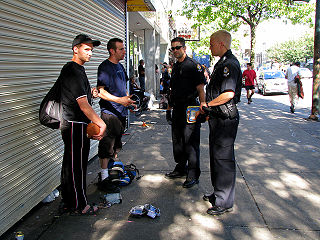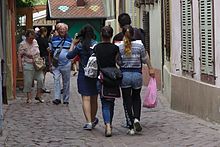
Theft is the act of taking another person's property or services without that person's permission or consent with the intent to deprive the rightful owner of it. The word theft is also used as a synonym or informal shorthand term for some crimes against property, such as larceny, robbery, embezzlement, extortion, blackmail, or receiving stolen property. In some jurisdictions, theft is considered to be synonymous with larceny, while in others, theft is defined more narrowly. A person who engages in theft is known as a thief.
Robbery is the crime of taking or attempting to take anything of value by force, threat of force, or by use of fear. According to common law, robbery is defined as taking the property of another, with the intent to permanently deprive the person of that property, by means of force or fear; that is, it is a larceny or theft accomplished by an assault. Precise definitions of the offence may vary between jurisdictions. Robbery is differentiated from other forms of theft by its inherently violent nature ; whereas many lesser forms of theft are punished as misdemeanors, robbery is always a felony in jurisdictions that distinguish between the two. Under English law, most forms of theft are triable either way, whereas robbery is triable only on indictment. The word "rob" came via French from Late Latin words of Germanic origin, from Common Germanic raub "theft".
Larceny is a crime involving the unlawful taking or theft of the personal property of another person or business. It was an offence under the common law of England and became an offence in jurisdictions which incorporated the common law of England into their own law, where in many cases it remains in force.

Shoplifting, shop theft, retail theft, or retail fraud is the theft of goods from a retail establishment during business hours, typically by concealing a store item on one's person, in pockets, under clothes or in a bag, and leaving the store without paying. With clothing, shoplifters may put on items from the store and leave the store wearing the clothes. The terms shoplifting and shoplifter are not usually defined in law. The crime of shoplifting generally falls under the legal classification of larceny. Shoplifting is distinct from burglary, robbery, or armed robbery. In the retail industry, the word shrinkage can be used to refer to merchandise lost by shoplifting, but the word also includes loss by other means, such as waste, uninsured damage to products and theft by store employees.
Distraction is the process of diverting the attention of an individual or group from a desired area of focus and thereby blocking or diminishing the reception of desired information. Distraction is caused by: the lack of ability to pay attention; lack of interest in the object of attention; or the great intensity, novelty or attractiveness of something other than the object of attention. Distractions come from both external sources, and internal sources. External distractions include factors such as visual triggers, social interactions, music, text messages, and phone calls. There are also internal distractions such as hunger, fatigue, illness, worrying, and daydreaming. Both external and internal distractions contribute to the interference of focus.

Jonathan Wild, also spelled Wilde, was a London underworld figure notable for operating on both sides of the law, posing as a public-spirited vigilante entitled the "Thief-Taker General". He simultaneously ran a significant criminal empire, and used his crimefighting role to remove rivals and launder the proceeds of his own crimes.

A fence, also known as a receiver, mover, or moving man, is an individual who knowingly buys stolen goods in order to later resell them for profit. The fence acts as a middleman between thieves and the eventual buyers of stolen goods who may not be aware that the goods are stolen.
Charles Hitchen, also mentioned as Charles Hitchin in other sources, was a "thief-taker" and under-marshal of the City of London in the early 18th century, also, famously tried for homosexual acts and sodomy offences. Alongside his former assistant and then a major rival Jonathan Wild, against whom he later published a pamphlet and contributed to his sentencing to death, Hitchen blackmailed and bribed people and establishments irrespective of their reputation, suspicious or respectable. Despite the disgrace of the people he earned through his abusive exercising of his power, he remained in power and continued fighting against violent crime, especially after the ending of the war of the Spanish Succession and until 1727.

Possession of stolen goods is a crime in which an individual has bought, been given, or acquired stolen goods.

Harry in Your Pocket is a 1973 comedy-drama film, about a team of professional pickpockets written by James Buchanan and Ronald Austin and directed by Bruce Geller, starring James Coburn, Michael Sarrazin, Trish Van Devere and Walter Pidgeon. Prior to release, the film was titled Harry Never Holds.

In English legal history, a thief-taker was a private individual hired to capture criminals. The widespread establishment of professional police in England did not occur until the 19th century. With the rising crime rate and newspapers to bring this to the attention of the public, thief-takers arose to partially fill the void in bringing criminals to justice. These were private individuals much like bounty hunters. However, thief-takers were usually hired by crime victims, while bounty hunters were paid by bail bondsmen to catch fugitives who skipped their court appearances and hence forfeited their bail. Both types also collected bounties offered by the authorities.
David Avadon, formerly "David Hutchins," was an American illusionist who billed himself as the country's "premier exhibition pickpocket." He lectured and wrote a book on pickpocketing and performed his trademark theatrical pickpocketing act for more than 30 years.
Apollo Robbins is an American sleight-of-hand artist, security consultant, self-described gentleman thief and deception specialist. Forbes has called him "an artful manipulator of awareness".

Crime in Cambodia is present in various forms.

This article discusses crime in Suriname.
Deborah Churchill (1677–1708) was a British pickpocket and prostitute executed for being an accomplice to murder in 1708.
Aharon Garushovich Galstyan, known as The Taxi Driver Poisoner, is an Armenian-born Russian serial killer and thief. Operating in St. Petersburg, he would drug his passengers with Azaleptin and rob them of their valuables, and in seven cases, his victims died, their bodies discarded near bodies of water. Despite his insistence on his innocence, Galstyan was found guilty and sentenced to life imprisonment with no chance of parole.

Yasutoshi Kamata, known as The Osaka Ripper, was a Japanese serial killer responsible for the murder and dismemberment of four women and one girl in Osaka between 1985 and 1994. The case was designated by the National Police Agency as "Metropolitan Designated Case No. 122".
Alexey Olegovich Vygovsky, known as The Station Poisoner, is a Russian serial killer and thief who, together with two accomplices, poisoned 32 people from 2006 to 2009 in the Moscow metro stations in order to rob them, resulting in 17 fatalities. For his crimes, he would later be convicted and sentenced to 22 years and 3 months imprisonment.
Luo Shubiao, known as The Rainy Night Butcher, was a Chinese serial killer and rapist. After committing a rape-murder in 1977 and serving a prison sentence for theft, he started targeting young women around Guangzhou, killing a further eighteen victims from 1990 to 1994. Luo would be convicted of these murders and subsequently executed a year later.

















